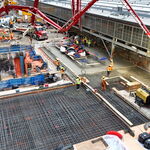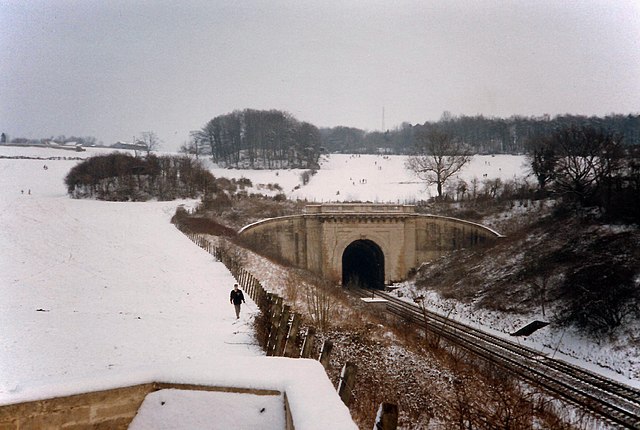lenaitch
Senior Member
Interesting desk top analysis. A couple of points:Given this discussion of 200 km/h running, here's where I can see that happening based on my non-scientific look at the existing Havelock ROW in Google Earth:
Existing 200km/h-plausible segment
There is a 16 km (10 mile) stretch of the existing ROW just east of Tweed which could be plausibly upgraded to 125 mph (200 km/h), marked in blue on the image below. The existing Havelock ROW generally has lots of sharp curves in this area because they made only the bare minimum investment to overcome geographic obstacles, but this particular segment has quite gentle curvature because it is following a ridgeline which itself is curving very gently. There are two sharp S-bends which would need to be bypassed, but that's less than a kilometre of realignment in total.
View attachment 334104
Due to the remote location, this segment only includes two road crossings (both of Sulfide Road).
This little 200 km/h zone would bring no significant travel time benefit on its own, but there also seems to be a case for new 200+ km/h lines on both sides of it.
Tweed Bypass
Immediately to the west of this segment is the town of Tweed, which is a significant political and logistical obstacle to the alignment. The existing ROW makes a sharp curve through the middle of town and crosses numerous streets at odd angles. Trains would need to slow to a crawl, and even then they would still be extremely annoying to the town residents, who would certainly demand a station as compensation. Instead, an 8 km (5 mi) bypass could be built through relatively easy terrain north and west of the town.
View attachment 334103
This segment would need a bridge over the Moira River, and I figure we might as well build it high enough to grade separate the two adjacent roads while we're at it.
View attachment 334102
Combined with the possible 200 km/h zone along the existing ROW, this bypass would produce a 26 km (16 mi) 200 km/h zone if all 7 crossings are grade-separated, or a 22 km ( 14 mi) zone if the line is only the 4 easternmost crossings are grade separated (including the two Sulfide Road crossings along the existing ROW). In both scenarios, one of the crossings is a minor road which could alternatively be closed rather than grade-separated.
Sharbot Lake Bypass
East of that existing 200km/h-plausible segment is the notoriously squiggly segment which includes ploughing through the centre of the town of Sharbot Lake. As a few others here have suggested, there may be an opportunity to build a new bypass railway north of Highway 7. Since the ridgelines in this area have very gentle curvature and are running parallel to the route, the new railway line would rarely need to cross them. So there is a chance that a new high speed line here could be relatively affordable despite the rocky terrain.
View attachment 334101
If the bypass rejoins the existing ROW east of Sharbot Lake, the length of new ROW required would be 49 km (30 mi). Combined with the possible 200 km/h zone along the existing ROW and the Tweed Bypass, there would be 75 km (47 mi) of continuous 200 km/h running.
Blue: >=200 km/h
Green: 145-180 km/h
Yellow: 105-130 km/h
Orange: 65-100 km/h
View attachment 334105
This is of course the 6-billion dollar question. But it is plausible that the Havelock alignment still provides better bang-for-the-buck than a lakeshore alignment even with the need to build new ROW through the Shield. The two bypass lines described above only total 55 km (37 mi) of new ROW. The rest of the existing ROW is actually fairly decent and could sustain quite good speeds with some curve realignments.
It's also worth noting that the net cost of jumping from 110 mph to 125 mph is pretty low in the Shield since there are few road crossings anyway, but building a new line along the lakeshore would mean either building tons of level crossings (not future-proof) or tons of grade separations (extremely expensive). The new lines through the Shield would also be somewhat future-proof for HSR, since it wouldn't be a big deal for an otherwise 300 km/h high speed line to slow down to 225 km/h for those 75 km through rocky terrain.
My most optimistic interpretation of the newly-discussed 200 km/h top speeds and 3h00 Toronto-Ottawa travel times is that the analysis showed that the HFR 1.0 plan wouldn't actually achieve 3h15 travel times in practice once those other factors are considered (urban slow zones, schedule padding etc). But if we do actually shell out for a 200+ km/h bypass of those really bad segments around Tweed and Sharbot Lake, it would become possible to actually beat that 3h15 target by a decent margin, even accounting for those factors.
- The original O&QR wasn't built with "bare minimum investment"; it was built in the 1880s with the technology of the day and in regard to the technology and speeds of the day,
- If any road, even a minor road, is a public road with property owners along it, they would have to be bought out if the road was severed without alternative. You can't strand them.
- There are many place enroute where buildings are quite close to the ROW, both in villages/settlements or simply randomly scattered. Given that we don't yet have a standard for trackage over 95mph (Class 5), I would think that, in developing that standard, there would be setback limitations.






